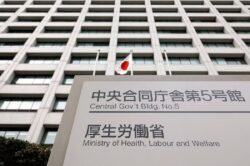
A COVID-19 booster vaccination venue in Meguro Ward, Tokyo
17:08 JST, February 4, 2022
Little progress has been made in the nation’s COVID-19 vaccination booster campaign, with only 4.4% of the population having received a third vaccine dose as of Wednesday.
On Jan. 21, Shigeru Omi, chairman of the government’s subcommittee on COVID-19 measures, and other experts referred to the possibility that the sixth wave of infections would reach its peak in about two weeks in areas under quasi-emergency measures.
The virus’ incubation period — the time between when someone is first exposed to the virus and when they develop symptoms — is believed to be about two days for the omicron variant. The average incubation period for the delta variant was about five days.
Some experts think this means the virus can spread quickly but infection cases will also decline quickly, but Takaji Wakita, director general of the National Institute of Infectious Diseases, said Wednesday, “It’s taking longer than expected” for cases to start decreasing.
Wakita cited slow progress in booster vaccinations as one of the reasons.
During the fifth wave of infections last summer when the delta variant was dominant, infection cases rapidly declined as progress was made in the vaccination rollout for elderly people. However, in the sixth wave, the booster uptake has been slow.

In Okinawa Prefecture, where quasi-emergency measures were adopted earlier than in other areas, cases peaked on Jan. 15, six days after the measures took effect, and then began to fall. However, the decline has been at a relatively slow pace.
According to infectious diseases expert Atsuo Hamada, a specially appointed professor at Tokyo Medical University, the decline in cases has also been slow in other countries in the northern hemisphere.
“In addition to the impact of the slow booster uptake, the spread of the virus might also be affected by winter environmental factors, such as temperature and humidity,” Hamada said.
The medical system is under increasing pressure amid the surge in coronavirus cases.
According to the Cabinet Secretariat, occupancy rates of beds secured for COVID-19 patients exceeded 50% as of Wednesday in Tokyo and 17 other prefectures. By prefecture, Kumamoto had the highest rate at 79%, while the rate was 70% in Osaka and 51% in Tokyo.
The occupancy rates of beds secured for COVID-19 patients with serious symptoms have also been on the rise, topping 10% in 15 prefectures, including Tokyo.
Wakita has stressed the importance of improving the booster uptake among senior citizens and other people at high risk of becoming seriously ill.
"Society" POPULAR ARTICLE
-

M4.9 Earthquake Hits Tokyo, Neighboring Prefectures
-

Israeli Tourists Refused Accommodation at Hotel in Japan’s Nagano Pref., Prompting Protest by Israeli Embassy and Probe by Prefecture
-

M7.5 Earthquake Hits Northern Japan; Tsunami Waves Observed in Hokkaido, Aomori and Iwate Prefectures
-

Tsukiji Market Urges Tourists to Avoid Visiting in Year-End
-

M5.7 Earthquake Hits Japan’s Kumamoto Pref., Measuring Upper 5 Intensity, No Tsunami Expected
JN ACCESS RANKING
-

Tokyo Economic Security Forum to Hold Inaugural Meeting Amid Tense Global Environment
-

Keidanren Chairman Yoshinobu Tsutsui Visits Kashiwazaki-Kariwa Nuclear Power Plant; Inspects New Emergency Safety System
-

Imports of Rare Earths from China Facing Delays, May Be Caused by Deterioration of Japan-China Relations
-

University of Tokyo Professor Discusses Japanese Economic Security in Interview Ahead of Forum
-

Japan Pulls out of Vietnam Nuclear Project, Complicating Hanoi’s Power Plans
























